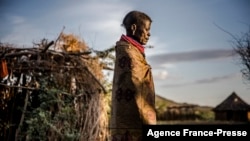The United Nations is issuing a $139-million flash appeal to provide assistance to 1.3 million people in Kenya hardest hit by a severe drought.
Millions of people across Kenya are suffering from two back-to-back seasons of poor rainfall, resulting in severe food shortages.
The latest Integrated Phase Classification, which analyzes the severity of food insecurity, finds nearly 370,000 Kenyans are in a state of emergency and two million others are in crisis.
World Food Program Resident Coordinator in Kenya Stephen Jackson, speaking via Zoom from the capital, Nairobi, says acute malnutrition rates are rising rapidly. He says 465,000 children and 96,000 pregnant and lactating women are acutely malnourished. He warns many are at imminent risk without urgent nutritional feeding.
On a visit to a clinic Thursday in Wajir, northern Kenya, he said people told him it had been more than a year since they last felt rain.
“I spoke with a young mother, Zeinab, who told me that she could not feed her children that morning and that she did not know if she would be able to put food on the table that evening. And that many of her livestock had already died because of the drought and those that are left are not in a good condition to sell. And you know, of course, in northern Kenya, livestock is the basis of life,” he said.
Jackson said problems arising from drought are compounded by the COVID-19 pandemic, insecurity, the recent locust infestations, and diseases.
The Kenyan government so far has allocated about $17 million to assist the most vulnerable drought victims and has announced another $20 million for this effort. However, Jackson said that is not enough and support from international donors is needed.
“The time to act is now. As I already stressed, if the October rains fail, that would be the third season in a row without rain. And we would be the end of this year be facing a much deeper crisis still. Something on the order of what we saw 10 years ago. So, any support we provide now will save lives and livelihoods,” Jackson said.
The 2011 East Africa drought caused a severe food crisis across the region, threatened the livelihoods of 9.5 million people and resulted in tens of thousands of deaths.
The current appeal will provide food and livelihoods, special nutritional treatment for acutely malnourished children and women, access to water, sanitation, and hygiene, health care, education, and other essential needs.
UN Appeals for Aid for Kenyan Drought Victims
- By Lisa Schlein

GENEVA —




